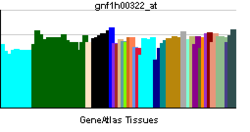- DLL4
-
Delta-like 4 (Drosophila) Identifiers Symbols DLL4; MGC126344; hdelta2 External IDs OMIM: 605185 MGI: 1859388 HomoloGene: 10411 GeneCards: DLL4 Gene Gene Ontology Molecular function • Notch binding
• calcium ion bindingCellular component • plasma membrane
• integral to membraneBiological process • angiogenesis
• cell communication
• signal transduction
• Notch signaling pathway
• Notch receptor processing
• multicellular organismal development
• blood circulation
• cell differentiation
• negative regulation of blood vessel endothelial cell migrationSources: Amigo / QuickGO RNA expression pattern 
More reference expression data Orthologs Species Human Mouse Entrez 54567 54485 Ensembl ENSG00000128917 ENSMUSG00000027314 UniProt Q9NR61 Q9DBU9 RefSeq (mRNA) NM_019074 NM_019454.3 RefSeq (protein) NP_061947 NP_062327.2 Location (UCSC) Chr 15:
41.22 – 41.23 MbChr 2:
119.15 – 119.16 MbPubMed search [1] [2] Delta like ligand 4 is a protein that in humans is encoded by the DLL4 gene.[1][2]
This gene is a homolog of the Drosophila delta gene. The delta gene family encodes Notch ligands that are characterized by a DSL domain, EGF repeats, and a transmembrane domain.[2]
References
- ^ Shutter JR, Scully S, Fan W, Richards WG, Kitajewski J, Deblandre GA, Kintner CR, Stark KL (Jul 2000). "Dll4, a novel Notch ligand expressed in arterial endothelium". Genes Dev 14 (11): 1313–8. PMC 316657. PMID 10837024. http://www.pubmedcentral.nih.gov/articlerender.fcgi?tool=pmcentrez&artid=316657.
- ^ a b "Entrez Gene: DLL4 delta-like 4 (Drosophila)". http://www.ncbi.nlm.nih.gov/sites/entrez?Db=gene&Cmd=ShowDetailView&TermToSearch=54567.
Further reading
- Yoneya T, Tahara T, Nagao K, et al. (2001). "Molecular cloning of delta-4, a new mouse and human Notch ligand.". J. Biochem. 129 (1): 27–34. PMID 11134954.
- Yan XQ, Sarmiento U, Sun Y, et al. (2002). "A novel Notch ligand, Dll4, induces T-cell leukemia/lymphoma when overexpressed in mice by retroviral-mediated gene transfer.". Blood 98 (13): 3793–9. doi:10.1182/blood.V98.13.3793. PMID 11739188.
- Mailhos C, Modlich U, Lewis J, et al. (2002). "Delta4, an endothelial specific notch ligand expressed at sites of physiological and tumor angiogenesis.". Differentiation 69 (2–3): 135–44. doi:10.1046/j.1432-0436.2001.690207.x. PMID 11798067.
- Dorsch M, Zheng G, Yowe D, et al. (2002). "Ectopic expression of Delta4 impairs hematopoietic development and leads to lymphoproliferative disease". Blood 100 (6): 2046–55. PMID 12200365.
- Strausberg RL, Feingold EA, Grouse LH, et al. (2003). "Generation and initial analysis of more than 15,000 full-length human and mouse cDNA sequences". Proc. Natl. Acad. Sci. U.S.A. 99 (26): 16899–903. doi:10.1073/pnas.242603899. PMC 139241. PMID 12477932. http://www.pubmedcentral.nih.gov/articlerender.fcgi?tool=pmcentrez&artid=139241.
- Liu ZJ, Shirakawa T, Li Y, et al. (2003). "Regulation of Notch1 and Dll4 by vascular endothelial growth factor in arterial endothelial cells: implications for modulating arteriogenesis and angiogenesis". Mol. Cell. Biol. 23 (1): 14–25. doi:10.1128/MCB.23.1.14-25.2003. PMC 140667. PMID 12482957. http://www.pubmedcentral.nih.gov/articlerender.fcgi?tool=pmcentrez&artid=140667.
- Tohda S, Murata-Ohsawa M, Sakano S, Nara N (2003). "Notch ligands, Delta-1 and Delta-4 suppress the self-renewal capacity and long-term growth of two myeloblastic leukemia cell lines". Int. J. Oncol. 22 (5): 1073–9. PMID 12684674.
- Shawber CJ, Das I, Francisco E, Kitajewski J (2003). "Notch signaling in primary endothelial cells". Ann. N. Y. Acad. Sci. 995: 162–70. doi:10.1111/j.1749-6632.2003.tb03219.x. PMID 12814948.
- Clark HF, Gurney AL, Abaya E, et al. (2003). "The secreted protein discovery initiative (SPDI), a large-scale effort to identify novel human secreted and transmembrane proteins: a bioinformatics assessment". Genome Res. 13 (10): 2265–70. doi:10.1101/gr.1293003. PMC 403697. PMID 12975309. http://www.pubmedcentral.nih.gov/articlerender.fcgi?tool=pmcentrez&artid=403697.
- Lauret E, Catelain C, Titeux M, et al. (2004). "Membrane-bound delta-4 notch ligand reduces the proliferative activity of primitive human hematopoietic CD34+CD38low cells while maintaining their LTC-IC potential". Leukemia 18 (4): 788–97. doi:10.1038/sj.leu.2403288. PMID 14990974.
- Zhang Z, Henzel WJ (2005). "Signal peptide prediction based on analysis of experimentally verified cleavage sites". Protein Sci. 13 (10): 2819–24. doi:10.1110/ps.04682504. PMC 2286551. PMID 15340161. http://www.pubmedcentral.nih.gov/articlerender.fcgi?tool=pmcentrez&artid=2286551.
- Gerhard DS, Wagner L, Feingold EA, et al. (2004). "The status, quality, and expansion of the NIH full-length cDNA project: the Mammalian Gene Collection (MGC)". Genome Res. 14 (10B): 2121–7. doi:10.1101/gr.2596504. PMC 528928. PMID 15489334. http://www.pubmedcentral.nih.gov/articlerender.fcgi?tool=pmcentrez&artid=528928.
- McKeane DP, Meyer J, Dobrin SE, et al. (2005). "No causative DLL4 mutations in periodic catatonia patients from 15q15 linked families". Schizophrenia Research 75 (1): 1–3. doi:10.1016/j.schres.2004.07.017. PMID 15820317.
- Patel NS, Li JL, Generali D, et al. (2005). "Up-regulation of delta-like 4 ligand in human tumor vasculature and the role of basal expression in endothelial cell function". Cancer Res. 65 (19): 8690–7. doi:10.1158/0008-5472.CAN-05-1208. PMID 16204037.
- Patel NS, Dobbie MS, Rochester M, et al. (2006). "Up-regulation of endothelial delta-like 4 expression correlates with vessel maturation in bladder cancer". Clin. Cancer Res. 12 (16): 4836–44. doi:10.1158/1078-0432.CCR-06-0285. PMID 16914569.
- Lefort N, Benne C, Lelièvre JD, et al. (2007). "Short exposure to Notch ligand Delta-4 is sufficient to induce T-cell differentiation program and to increase the T cell potential of primary human CD34+ cells". Exp. Hematol. 34 (12): 1720–9. doi:10.1016/j.exphem.2006.08.007. PMID 17157169.
- Fung E, Tang SM, Canner JP, et al. (2007). "Delta-like 4 induces notch signaling in macrophages: implications for inflammation". Circulation 115 (23): 2948–56. doi:10.1161/CIRCULATIONAHA.106.675462. PMID 17533181.
- Hodkinson PS, Elliott PA, Lad Y, et al. (2007). "Mammalian NOTCH-1 activates beta1 integrins via the small GTPase R-Ras". J. Biol. Chem. 282 (39): 28991–9001. doi:10.1074/jbc.M703601200. PMID 17664272.
- Zang S, Ji Ch, Qu X, et al. (2007). "A study on Notch signaling in human breast cancer". Neoplasma 54 (4): 304–10. PMID 17822320.
Signaling pathway: notch signaling pathway Receptor on signaling cell Ligand Receptor on receiving cell B trdu: iter (nrpl/grfl/cytl/horl), csrc (lgic, enzr, gprc, igsr, intg, nrpr/grfr/cytr), itra (adap, gbpr, mapk), calc, lipd; path (hedp, wntp, tgfp+mapp, notp, jakp, fsap, hipp, tlrp) Categories:- Human proteins
- Chromosome 15 gene stubs
Wikimedia Foundation. 2010.
